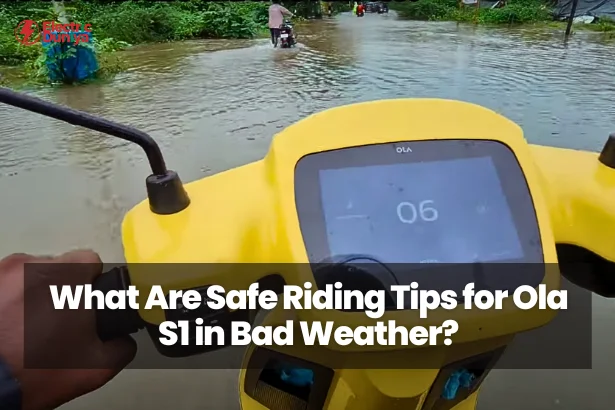So you’ve chosen the electric scooter life, and you’re cruising around town on your Ola S1.
But what happens when the weather throws a curveball?
Rain, wind, fog – these conditions can make even the most seasoned rider cautious.
Don’t worry, with a few smart tips, you can navigate bad weather on your S1 like a pro!
1. Gear Up for the Conditions
Dress for Safety:
This might seem obvious, but it’s crucial.
Wear a full-face helmet that provides good visibility.
Opt for a rain jacket and pants made of waterproof material.
Proper footwear with a good grip is essential, especially when the roads are wet.
Remember, staying dry and comfortable will help you stay focused on the ride.
See and Be Seen:
During rain or low-light conditions, visibility becomes paramount.
Ensure your headlight is on and bright and avoid using a high beam in fog.
Then turn on the hazard lights to further increase your visibility to other vehicles.
Consider reflective gear on your clothing or scooter for added visibility.
2. Handle Your Ride in the Wet
Slow and Steady Wins the Race:
Wet roads mean reduced traction.
Avoid sudden braking or acceleration, and focus on a smooth, controlled riding style.
Remember, it takes longer to stop on a wet surface, so increase your following distance and anticipate situations that might require braking.
Beware of Puddles:
Large puddles can hide potholes or uneven surfaces.
If you must ride through a puddle, do so slowly and carefully.
Hitting a hidden pothole at speed can cause a loss of control.
Watch Out for Standing Water:
Deep puddles or flooded roads can be dangerous.
If you need more clarification on the depth, it’s always best to avoid them or find an alternative route.
Riding through deep water can damage your scooter’s electrical components.
3. Manage the Extreme Wind
Lean into it:
Strong winds can push your scooter slightly.
Gently lean into the wind to maintain stability.
However, avoid over-correcting, as this can lead to wobbly handling.
Hold on Tight:
Keep a firm grip on the handlebars, especially when facing strong wind gusts.
A loose grip can make it harder to maintain control.
Mind the Gap:
Wind can be more noticeable when riding near larger vehicles like trucks or buses.
Maintain a safe distance to avoid being buffeted by sudden air pressure changes.
4. Taming the Fog
Low and Slow is the Motto:
Fog significantly reduces visibility.
Ride slowly and with extreme caution.
Use your low beam headlight to see the road directly in front of you, and avoid using the high beam as it can reflect off the fog particles and further obscure your vision.
Follow the Others:
If you must ride in fog, try to follow another vehicle at a safe distance.
Their headlights can help you see the road ahead.
However, maintain your own pace and don’t tailgate.
Alert:
Fog can be unpredictable.
Be extra vigilant for potential hazards like sudden stops, pedestrians, or animals that might be harder to see in low visibility conditions.
5. General Bad Weather Tips
Plan Your Ride:
If possible, avoid riding during heavy rain, strong winds, or dense fog.
If you must venture out, plan your route carefully and check the weather forecast beforehand.
Listen to Your Body:
Riding in bad weather can be tiring.
Take breaks when needed and avoid pushing yourself too hard.
If conditions become too difficult, it’s always okay to find shelter and wait for the weather to improve.
Be Extra Alert:
Bad weather requires heightened awareness.
Pay close attention to the road surface, potential hazards, and other vehicles.
Avoid distractions like using your phone while riding.
Final Thoughts
Remember, your safety is paramount.
By following these tips and using your judgment, you can confidently navigate bad weather on your Ola S1.
So, stay safe out there, and happy riding!







